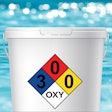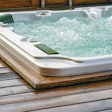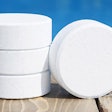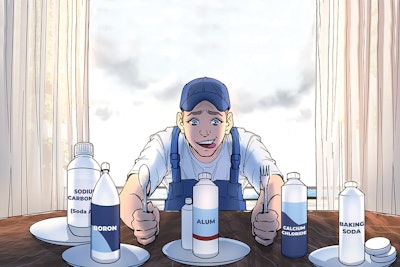
Do you gill good burgers? That's the holy grail — a great hamburger. You'll never find one as good as the one you cook yourself. Not in a restaurant, anyway. Soooo good that there's no condiments needed.
Nevertheless, at a cookout, I sat at a table covered with condiments, relishing that incredible flavor only a perfect bun-to-burger ratio can produce. My eyes came to rest on a jar of pickles — brand facing away from me — and lazily scanned the ingredients. There were the things you'd expect: cucumbers, water, vinegar, salt. I wouldn't have guessed red bell pepper, but okay, whatever. Then, my eyebrows shot up as I saw something I have on my route truck, a chemical I use on my pools: calcium chloride.
I use that to increase calcium hardness. It's a significant factor in balancing pool water. However, as my pickle jar label indicates, it is also a key ingredient in pickle brine. The calcium chloride contributes to the preservation of pickles, helping extend their shelf life and preventing them from becoming mushy.
I saw something else on that pickle jar label that I use in pools: Aluminum sulfate (Alum). I use it primarily as a floc. Apparently, it is also used in pickling to preserve the bright green color of pickles, by creating an environment where harmful bacteria cannot thrive.
In fact, as I've discovered in researching this article, Alum is used in bread and cake recipes, in doses as high as 100 ppm. Next time you're in the supermarket, take a walk down the spice aisle. It is right in the middle of the McCormick's Spice display. Alum!
Now, as my friend Wayne Ivusich — I'm sure you remember him as the Titan of Titration and the Ruler of Reagents — likes to say, "People want to swim in water, they don't want to swim in chemicals," which is so true. They don't. They're suspicious of them.
They think: Chemicals, bad. Pickles and cake, good!
But as I've just demonstrated, sometimes it's the same chemicals. Which really proves the point that it's wrong to denounce all chemicals without distinction, same as it's wrong to denounce all people in a group without distinction.
It's really the amounts that are most important.
When adding things to pools, and addressing the concerned faces of questioning customers, I've always used my tuna fish analogy: Do you eat tuna fish? You do? (That's okay, ma'am. According to surveys, three out of four Americans do, too.) Now, let me ask you: Is it okay to eat tuna fish daily? No? Why not?
That's right, because it contains mercury. IT CONTAINS MERCURY! But people still eat it. Why? Because tuna fish is okay to eat as long as you stay within the recommended guidelines, right? It's the same thing here. We use chemicals within the recommended guidelines, and we're good. Most guidelines for chemicals in pool water mirror those in the EPA's guidelines for drinking water, which we gulp down without a thought.
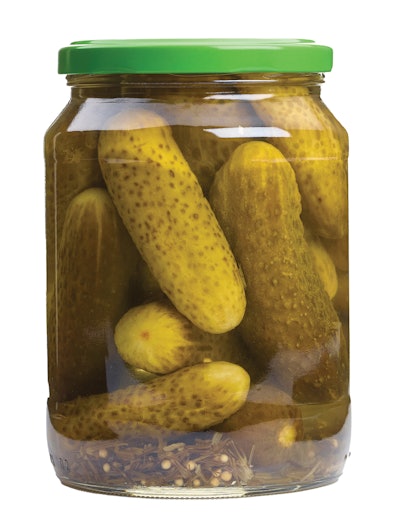 Both alum and calcium chloride are in the brine of these crunchy, savory pickles.
Both alum and calcium chloride are in the brine of these crunchy, savory pickles.
FRUITS AND VEGETABLES
You thought that's all? Calcium chloride and Alum? Just getting started. Let's talk about boron, and the form we use in pools, borate.
When chlorine became challenging to find in the pandemic years, borate saw a resurrection in popularity, and with good reason: The oxyanion is an algastat (aids in preventing algae from becoming established), which means using it could help stretch our chlorine supply.
Before that, the primary use of borates in swimming pools was to buffer against an upward drift in pH. Water feeling softer on the skin is a side perk of establishing a borate level in a swimming pool, as well as enhanced water clarity and additional protection against solar U.V. chlorine degradation. However, boron, the element in borate, is also a mineral that occurs naturally in the environment. It can be found in a lot of foods, like fruits and vegetables, such as avocados, oranges, apples, bananas, pears and peaches, as well as broccoli, cauliflower, carrots, spinach, potatoes, tomatoes and onions.
Again: Chemicals, bad. But fruits and vegetables, good!
What about algaecides and algaestats?
Well, copper, which we use in pools to fight algae, is an essential nutrient for the body. Together with iron, it enables the body to form red blood cells. Sufficient copper in the diet may help prevent cardiovascular disease and osteoporosis, too.
Poly [oxyethylene (dimethylimiunio)- ethylene (dimethyliminio)-ethylenedichloride] is the active ingredient in what we call a Polyquat, or POD, or sometimes Poly 60, or some other number that indicates the percentage in a specific algaecide.
You're not likely to find it on the ingredient list of the foods you purchase because it's an unintended additive used to treat the water used to make the product. Still, you eat it all the time. You'll find traces in fruit juices, refined sugars, wine, beer, dairy products, and a host of other processed foods. Again, it's the amount that is important.
 Bicarb, a common pool chemical, is baking soda, the key ingredient in baking scrumptious apple pie!
Bicarb, a common pool chemical, is baking soda, the key ingredient in baking scrumptious apple pie!
AS WHOLESOME AS APPLE PIE
Best of all is old fashioned baking soda, used to make apple pie!
Baking soda is the "chemical" we use to increase total alkalinity, but we call it sodium bicarbonate. It's used in all kinds of baked goods (bicarb reacts with acidic components in the batter, producing carbon dioxide gas that helps the dough or batter rise), from pancakes and waffles to biscuits, pretzels, crackers and quick breads, like banana bread and zucchini bread, to create a rise without needing yeast. Baking soda is even added to the water when boiling particular types of pasta to help it cook evenly and maintain texture.
Wait for it…
Chemicals, bad. Pancakes and waffles, good!
Let's not forget soda ash (sodium carbonate). That is the chemical we use to raise pH in every state in the country except Florida. Chinese steamed buns often use a small amount of soda ash (sometimes listed in the ingredients as "alkaline salts" or "lye water") to achieve the desired texture and color. The sodium carbonate also helps the buns' browning and affects their chewiness. Traditional pretzel recipes sometimes use a food-grade solution of sodium carbonate or sodium bicarbonate (baking soda) to dip the pretzels in before baking because it gives pretzels that pretzel crust and pretzel flavor. Also, some Asian noodle recipes, especially ramen, use sodium carbonate to give the noodles a familiar texture and color.
Large quantities of soda ash in foods can lead to health risks; but it's the amount that's important. It is considered safe for consumption in minimal doses.
D.E., TOO? YOU'VE GOT TO BE KIDDING
Some people, let's call them morons, consume "food-grade" diatomaceous earth. We also call this powder D.E., and use it to filter pool water. It comes from the exceptionally well-preserved (not fossilized) silica shell wall of prehistoric diatoms (mustard algae). For some reason, the D.E. eaters believe it offers health benefits. I'd say they 'drank the Kool-Aid,' but saying they 'dined on the diatom' is more accurate. Even though there is little to no supporting evidence, some filter media munchers think they'll get a digestive 'cleansing,' ridding their bodies of worms, parasites, and toxins from the gut. Others claim it benefits their cholesterol, skin, hair and nails. Then, some look to D.E. as a source of silica to strengthen hair and bones. Again, these claimed benefits lack substantial scientific support, so if you are considering swallowing D.E. for a digestive backwash, please consult a doctor first. And try not to inhale the powder.
What does all this add up to? One man's pool chemical is another man's delicious repast. And a customer's prejudice against all chemicals is usually a matter of ignorance. From swimming pools to plates, health and safety comes down to amounts and dosing and keeping within recommended ranges.
(Think about pool chemicals the next time you bite into a tangy, delicious pickle!)




























